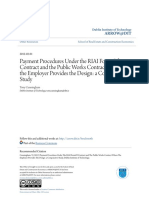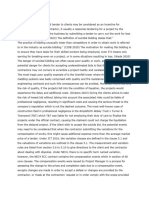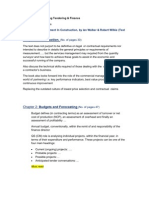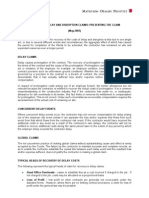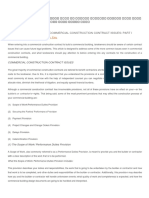Retention Fund
Retention Fund
Uploaded by
NicolesChuaCopyright:
Available Formats
Retention Fund
Retention Fund
Uploaded by
NicolesChuaOriginal Description:
Original Title
Copyright
Available Formats
Share this document
Did you find this document useful?
Is this content inappropriate?
Copyright:
Available Formats
Retention Fund
Retention Fund
Uploaded by
NicolesChuaCopyright:
Available Formats
Criteria Disputes between Employer and Contractor caused by Retention Fund
Introduction of Criteria Retention is an important feature of the construction industry. The retention system has been part of the construction industry for many years and most standard forms of building contracts provide for the deduction of retention from sums otherwise due to main contractor and sub-contractor.
Retention fund is deducted first by the employer who has employed the main contractor and then the deduction of retention is usually mirrored in all subsidiary contracts throughout the supply chain. Although the retention sum has been earned by the main contractor, it is not yet payable because of other contract provisions providing for its deductions. The retention fund is intended to provide the employer with some protection against the failure by a contractor to remedy defects in the work, and it is usual practice for one half of the retention to be released on practical completion of the works and the second half following the making good of any defects.
The Construction Industry Development Board (CIDB) Form of Contract
for Building Works has its retention sum provision under clause 42.3. The CIDB contract goes further to state that the retention sum is to be kept by the employer in a separate bank account as well as to provide to the Contractor statement of account when making interim payments to the Contractor. Whereas the PAM and IEM contracts are silent as to the retention money held in trust is to be kept in a separate account. What Is The Recent Position On Retention Sums in Malaysia by the Entrusty Group.
The retention fund has been the cause for many disputes between the Employer and
Contractor. First of these is that the Employer never set up a trust fund for the retention fund. Secondly, when the time comes for the releases of the retention sum, the Employer refuse to release the retention sum; usually citing its right to set-off against monies due from the Contractor for the Contractors alleged defaults. It is not very fair to the Contractor. Due to the set-off of Employer, It may cause many disputes between Employer and Contractor.
Issue Statement
In the High court case of Teh Ah Khoon Enterprise Sdn Bhd v Puncakdana Sdn Bhd [2005] 2 AMR 52. In this cases, Plaintiff The Ah Khoon Enterprise is the Contractor and has entered into a contract with the Defendant, Puncakdana Sdn Bhd who is the Employer for the construction of a condominium project under the PAM 98 Contract. After disputes have arisen, the Employer determined the employment of the Contractor and set-off from the retention sum for Liquidated Damages claim against the Contractor for its failure. The Contractor then applied to the court to have the Employer to keep the retention sum in a separate trust account and restrain the Employer from using the retention sum. The cases above had proof that, the Contractor is really dissatisfied because of the Employer release of the retention sum, usually citing its right to set-off against monies due from the Contractor and also the Employer never set up a trust fund for the retention sum. Another statement, Ang Su Sin (2006) in his Payment study on Present Payment Issues The Present Dilemmas of Malaysian Construction Industry mentioned that the construction industry is always in dispute prone. It is therefore common for the claimant pursuing his claim for works and services rendered to meet with a cross claim instead for defective work, delayed completion etc. So, payment is always postponed until the resolution of the dispute.
Solution In real practice, the employer is rarely set up a trust account for the retention fund. And this had formed a risk to the contractor. It is the obligation of the employer as a trustee to set up a trust fund to keep the retention sum for the employer to set off against the claim for liquidated and ascertained damages. The contractor should have the employer to create trust account in precedent to protect and promise the retention fund is receivable by the contractor. (The Entrusty Group 2006) As some employers are refuse to release the retention fund by citing the right to set off against monies. It is a good practice to have a set off or recover the costs incurred from the Performance Bond but not from retention fund. (Oon, Chee Kheng. 2002). JKR sub-clause 48.2 allows the Engineer/SO to make good such defects, shrinkages or their faults if the Contractor fails to comply and to deduct the costs incurred in making good the defects from the monies due or recover from the Performance Bond or as liquidated demand in money. If the defects, shrinkages or other faults are impracticable or inconvenient to the Employer to have the Contractor make good these defects and faults, JKR sub-clause 48.3 allows the Engineer to ascertain the diminution in value of the Works due to the said defective or faulty works and deduct such value from the Performance Bond or as liquidated demand in money. Reference The Entrusty Group. (2006). What Is The Recent Position On Retention Sums In Malaysia? Master Builders 1st Quarter 2006.
Oon, C.K. (2002). Standard Construction Contracts in Malaysia. CKOON & Co. Advocates and Solicitors.
You might also like
- Gaso Transport Services V Obene Ealr 1990-1994 Ea 88Document12 pagesGaso Transport Services V Obene Ealr 1990-1994 Ea 88Tumuhaise Anthony Ferdinand100% (1)
- Donation Inter Vivos - SampleDocument3 pagesDonation Inter Vivos - SampleLen Tao100% (1)
- Final Report of Anonymous Letter Investigation - Copeland Investigations RedactedDocument271 pagesFinal Report of Anonymous Letter Investigation - Copeland Investigations RedactedKevin Stone100% (2)
- Payment Procedures Under The RIAI Form of Contract and The PublicDocument12 pagesPayment Procedures Under The RIAI Form of Contract and The PublicAbd Aziz MohamedNo ratings yet
- Certificate of Making Good DefectsDocument3 pagesCertificate of Making Good DefectslaikienfuiNo ratings yet
- Claims & DisputeDocument43 pagesClaims & DisputeSujani Maarasinghe100% (1)
- Application of Loss of ProfitDocument3 pagesApplication of Loss of ProfitBritton WhitakerNo ratings yet
- Defects Liability PeriodDocument5 pagesDefects Liability PeriodChemical.AliNo ratings yet
- Irregularities, Frauds and the Necessity of Technical Auditing in Construction IndustryFrom EverandIrregularities, Frauds and the Necessity of Technical Auditing in Construction IndustryNo ratings yet
- G.R. No. 214064Document9 pagesG.R. No. 214064Ran NgiNo ratings yet
- Product Supply Agreement B2BDocument5 pagesProduct Supply Agreement B2BArjun ZmNo ratings yet
- What Is The Recent Position On Retention Sums in Malaysia?: RticleDocument3 pagesWhat Is The Recent Position On Retention Sums in Malaysia?: RticleJordan TeeNo ratings yet
- Retention MoneyDocument4 pagesRetention Moneyola789No ratings yet
- Issues On Sub-Contract's Direct Payment - 221219 - 123348Document7 pagesIssues On Sub-Contract's Direct Payment - 221219 - 123348Nazreen Farina Ahmad SabriNo ratings yet
- SLQS Qatar CPD No. 101 - Payment Delays in The Construction Industry by Mr. Uditha Tharanga - PresentationDocument31 pagesSLQS Qatar CPD No. 101 - Payment Delays in The Construction Industry by Mr. Uditha Tharanga - Presentationben hurNo ratings yet
- Contractor's Remedies For Late or Non-PaymentDocument4 pagesContractor's Remedies For Late or Non-PaymentZinck HansenNo ratings yet
- Contractors Right of Action For Late or Non Payment by The EmployerADocument31 pagesContractors Right of Action For Late or Non Payment by The EmployerArokiahhassan100% (1)
- Employer's Obligations - Payment - Construction ContractDocument5 pagesEmployer's Obligations - Payment - Construction ContractViendong LeNo ratings yet
- CONM40018 CWK Contract AdminDocument8 pagesCONM40018 CWK Contract Adminirislin1986No ratings yet
- Contracts - Basic Questions Question - Answer - International Federation of Consulting EngineersDocument27 pagesContracts - Basic Questions Question - Answer - International Federation of Consulting EngineersDaniel YitbarekNo ratings yet
- The Causes of Late Payment by Contractor and The Effects To The ClientDocument10 pagesThe Causes of Late Payment by Contractor and The Effects To The ClientNazirah NazeriNo ratings yet
- The Cost of Delay and Disruption 2Document12 pagesThe Cost of Delay and Disruption 2Khaled AbdelbakiNo ratings yet
- The Cost of Delay and DisruptionDocument11 pagesThe Cost of Delay and DisruptionAmir Shaik100% (1)
- In Conclusion Following The Above Said The Best Advice For The Contractor Is: To Give Notice Timeously, in Writing, and in Terms and Condition of The Contract To Keep Adequate RecordsDocument8 pagesIn Conclusion Following The Above Said The Best Advice For The Contractor Is: To Give Notice Timeously, in Writing, and in Terms and Condition of The Contract To Keep Adequate RecordswahringerNo ratings yet
- A Guide To Claims Procedures in FIDIC 1999 Standard Forms of Contract For Major Works.Document9 pagesA Guide To Claims Procedures in FIDIC 1999 Standard Forms of Contract For Major Works.Rajendra TharmakulasinghamNo ratings yet
- EPC Contracts in India 1725560816Document10 pagesEPC Contracts in India 1725560816gauri shyamNo ratings yet
- F311 PTF Reading NotesDocument46 pagesF311 PTF Reading NotesYasser ElsalhyNo ratings yet
- Conditions of Sub-Contracts ERA Sub-Contract Framework ManagementDocument11 pagesConditions of Sub-Contracts ERA Sub-Contract Framework Managementyesuf abdulhakim50% (2)
- Fidic AhsanDocument15 pagesFidic AhsanEhsan ShNo ratings yet
- Emplyer's ClaimDocument14 pagesEmplyer's ClaimHiwotNo ratings yet
- Conditions Precedent To Recovery of Loss and ExpensesDocument9 pagesConditions Precedent To Recovery of Loss and Expenseslengyianchua206No ratings yet
- Raheel Aamir: How To Avoid Losing The Contractor'S Construction ClaimsDocument20 pagesRaheel Aamir: How To Avoid Losing The Contractor'S Construction ClaimsKhaled AbdelbakiNo ratings yet
- RIBA Loss and Expense GuideDocument13 pagesRIBA Loss and Expense GuidekasunNo ratings yet
- Pay When PaidDocument10 pagesPay When PaidZinck HansenNo ratings yet
- Successful Delay and Disruption Claims: Presenting The Claim (May 2005)Document3 pagesSuccessful Delay and Disruption Claims: Presenting The Claim (May 2005)mullanaNo ratings yet
- BSR 609 ContractDocument4 pagesBSR 609 ContractAliff haiqalNo ratings yet
- Negotiation of Construction ClaimsDocument27 pagesNegotiation of Construction ClaimsGiora Rozmarin100% (3)
- LIQUIDATED-DAMAGES-Case Studies-Anamul HoqueDocument11 pagesLIQUIDATED-DAMAGES-Case Studies-Anamul HoqueMuhammad Anamul HoqueNo ratings yet
- Clauses To ClaimDocument14 pagesClauses To ClaimchanakawidNo ratings yet
- Contract 12 - NEC3 - Early Warning and Compensation EventsDocument5 pagesContract 12 - NEC3 - Early Warning and Compensation Eventsjon3803100% (1)
- Retention in ConstructionDocument2 pagesRetention in ConstructionRanjith Ekanayake100% (2)
- LD & GD - Apr 2022Document20 pagesLD & GD - Apr 2022Anonymous pGodzH4xLNo ratings yet
- The Most Common Commercial Construction Contract Issues: Part IDocument23 pagesThe Most Common Commercial Construction Contract Issues: Part IHanna HaileNo ratings yet
- Case Study For Contract Management - Hydro Power Projects PDFDocument4 pagesCase Study For Contract Management - Hydro Power Projects PDFpradeepsharma62100% (1)
- Construction Contracts - A Comparison Between The FIDIC Red Book and The 2010 MDB Conditions PDFDocument3 pagesConstruction Contracts - A Comparison Between The FIDIC Red Book and The 2010 MDB Conditions PDFsenthilNo ratings yet
- Tender - Prop3Document57 pagesTender - Prop3aecinventory6No ratings yet
- NEC and CLC Guidance For Dealing With Retention Payments Under NEC3 and NEC4 Contracts 15.11.22Document5 pagesNEC and CLC Guidance For Dealing With Retention Payments Under NEC3 and NEC4 Contracts 15.11.22George ParsonsNo ratings yet
- Time Related DelayDocument2 pagesTime Related DelayMohamed El AbanyNo ratings yet
- Contractor's Right of Action For Late or Non-Payment by The EmployerDocument31 pagesContractor's Right of Action For Late or Non-Payment by The Employerimran yusopNo ratings yet
- Liquidated Damages ResearchDocument11 pagesLiquidated Damages ResearchNatarajan SaravananNo ratings yet
- Era TheoryDocument10 pagesEra TheoryYash Raj GairaNo ratings yet
- Using A Retention BondDocument2 pagesUsing A Retention Bondvivekjn100% (1)
- A Guide To ClaimsDocument13 pagesA Guide To ClaimsTalal KhanNo ratings yet
- Completion, Taking Over and The Taking Over Certificate in Construction - Why Itâ S ImportantDocument3 pagesCompletion, Taking Over and The Taking Over Certificate in Construction - Why Itâ S ImportantMohamed El Abany100% (1)
- Q&A On FIDIC Orange BookDocument10 pagesQ&A On FIDIC Orange BookHiwotNo ratings yet
- Contract (Guarantees, Bonds and Retentions)Document3 pagesContract (Guarantees, Bonds and Retentions)The UntamedNo ratings yet
- Lesson 7 - Engineering ContractDocument106 pagesLesson 7 - Engineering ContractIsaack MgeniNo ratings yet
- JBCC Notes Cpnstruction Guarantees 20160801Document18 pagesJBCC Notes Cpnstruction Guarantees 20160801Thabo SeaneNo ratings yet
- Cipaa 2012: An Overview: IngenieurDocument2 pagesCipaa 2012: An Overview: IngenieurCalvin KewNo ratings yet
- PNACU619Document33 pagesPNACU619PAUL JEREMIAH DeleonNo ratings yet
- Jun 11-Q&A-1Document22 pagesJun 11-Q&A-1pdkprabhath_66619207No ratings yet
- MBJ Vol 4 2010Document9 pagesMBJ Vol 4 2010LokuliyanaNNo ratings yet
- Contract Administration Pitfalls and Solutions for Architect-Engineering Projects: A JournalFrom EverandContract Administration Pitfalls and Solutions for Architect-Engineering Projects: A JournalNo ratings yet
- UntitledDocument101 pagesUntitledelzu maglanaNo ratings yet
- JB 323 - Pacific 22Document1 pageJB 323 - Pacific 22Leo ChalimNo ratings yet
- Cavite Mutiny 1) Compare and Contrast The Accounts On Cavite Mutiny Using The Venn Diagram AboveDocument3 pagesCavite Mutiny 1) Compare and Contrast The Accounts On Cavite Mutiny Using The Venn Diagram AboveRuth VargasNo ratings yet
- Humilde-Irene2 122922 2 2Document2 pagesHumilde-Irene2 122922 2 2Romeo CruzNo ratings yet
- Iranian Banks To Open in India: Jnanpith For Gujarati WriterDocument1 pageIranian Banks To Open in India: Jnanpith For Gujarati WriterMundarinti Devendra BabuNo ratings yet
- Lamis Vs Ong (Batch 5)Document5 pagesLamis Vs Ong (Batch 5)michi barrancoNo ratings yet
- Legal Notice Defamation Raja ShahzadDocument5 pagesLegal Notice Defamation Raja Shahzadazamkhan13No ratings yet
- Chang - The Monstrous-Feminine in The Incel ImaginationDocument18 pagesChang - The Monstrous-Feminine in The Incel ImaginationHenrique FernandesNo ratings yet
- Unenforceable Contract.Document27 pagesUnenforceable Contract.Lucky DanielNo ratings yet
- Qayin & Hebel (Chapter.2)Document22 pagesQayin & Hebel (Chapter.2)Behaviour Revolution100% (1)
- What Should Then Be Done and THE TRAVELLER - IIS - Allama IqbalDocument35 pagesWhat Should Then Be Done and THE TRAVELLER - IIS - Allama IqbalInternational Iqbal Society100% (1)
- Newsound Broadcasting Network vs. DyDocument30 pagesNewsound Broadcasting Network vs. Dyj0% (1)
- Intestate of Luther Young and Pacita Young, PACIFICA JIMENEZ vs. BUCOYDocument2 pagesIntestate of Luther Young and Pacita Young, PACIFICA JIMENEZ vs. BUCOYKaye Miranda LaurenteNo ratings yet
- Arrest Warrants For Darius Miles and Michael DavisDocument10 pagesArrest Warrants For Darius Miles and Michael DavisAshley RemkusNo ratings yet
- Vilas Vs City of Manila Case DigestDocument10 pagesVilas Vs City of Manila Case DigestSyd Geemson ParrenasNo ratings yet
- Self-Emancipation and 4B MovementDocument2 pagesSelf-Emancipation and 4B MovementAnjehyn ElleNo ratings yet
- Lui V MatillanoDocument38 pagesLui V MatillanoKatrina BudlongNo ratings yet
- LIZA L. MAZA v. EVELYN A. TURLADocument6 pagesLIZA L. MAZA v. EVELYN A. TURLATenten Belita PatricioNo ratings yet
- Cheruseethi ThangalDocument11 pagesCheruseethi ThangalMoosathasleem ArimbraNo ratings yet
- Hibachi Sushi LawsuitDocument13 pagesHibachi Sushi LawsuitMontgomery AdvertiserNo ratings yet
- Jekykll Hyde Revision Cards 1956121Document5 pagesJekykll Hyde Revision Cards 1956121ameliakowalska707No ratings yet
- Macbeth AnalysisDocument14 pagesMacbeth Analysissisinityw100% (6)
- Introduction To Juvenile DelinquencyDocument34 pagesIntroduction To Juvenile DelinquencyLasania DentonNo ratings yet
- Life and Works of Francisco de GoyaDocument2 pagesLife and Works of Francisco de GoyaAudsNo ratings yet
- Prophet Yunus DuaDocument37 pagesProphet Yunus DuaAbir KaziNo ratings yet



